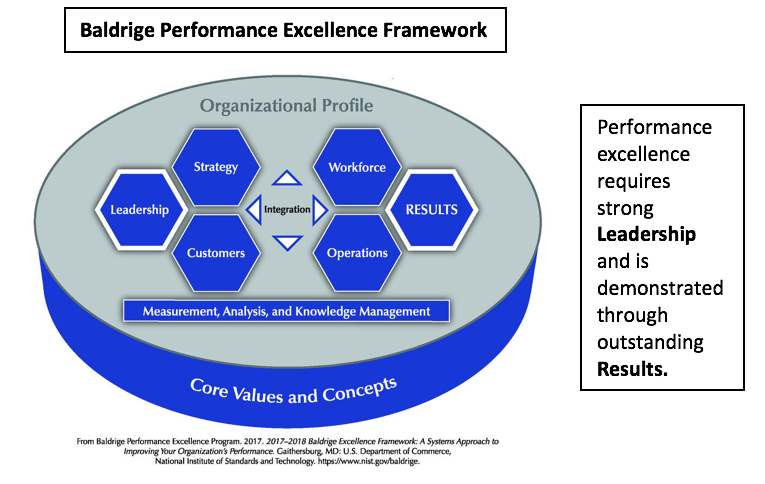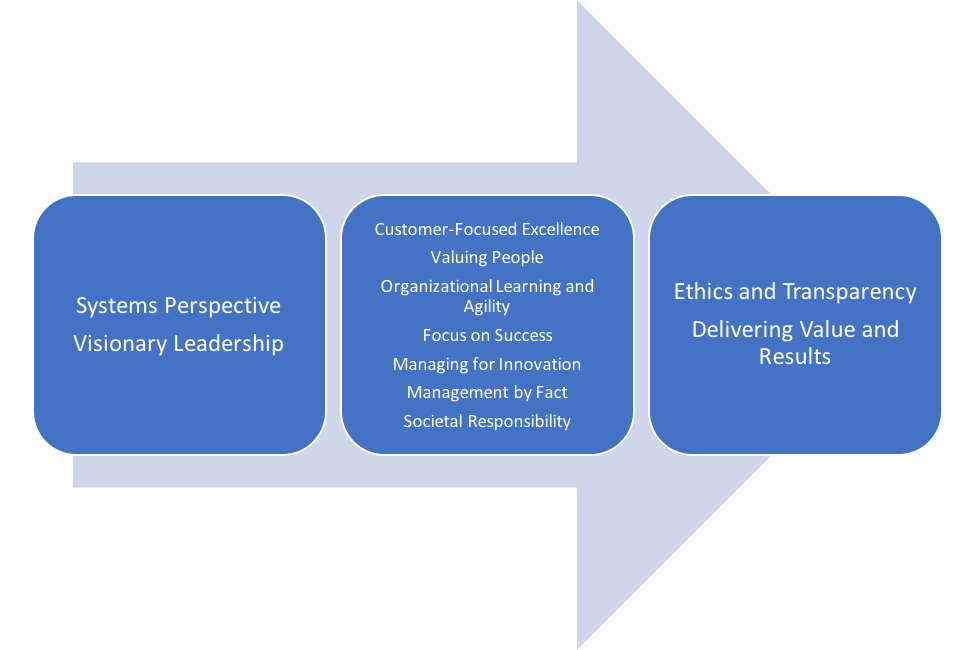My name is Jennifer Dewey, and I chair the Business, Leadership, and Performance TIG, working closely with Kristy Moster, the TIG’s Program Chair. We’re highlighting key issues important to our members this week.
These issues – leadership, business priorities, knowledge management, and workforce engagement – address categories in the Baldrige Excellence Framework (http://www.nist.gov/baldrige/publications/baldrige-excellence-framework) whose purpose is to help all organizations determine: 1) Is my organization doing as well as it could? 2) How do I know?, and 3) What and how should my organization improve or change?
The Framework includes the Criteria for Performance Excellence and Core Values and Concepts. The Framework promotes a systems perspective, i.e., managing all the components of an organization as a unified whole to achieve its mission, ongoing success and performance excellence.
The Criteria for Performance Excellence includes an Organizational Profile that describes an organization’s background and sets the context for the methods used to accomplish work and resulting outcomes. The leadership process triad (Leadership, Strategy, and Customers) emphasizes a leadership focus on strategy and customers. The results triad (Workforce, Operations, and Results) includes workforce-focused processes, key operational processes, and the performance results they generate. “Integration” at the center of the figure indicates the system elements are interrelated. The system foundation (Measurement, Analysis, and Knowledge Management) is critical to a fact-based, knowledge-driven, agile system to improve performance and competitiveness. All actions lead to Results related to products and processes, customers, workforce, leadership and governance, and financial and market outcomes.
Hot Tip: The Criteria does not prescribe how users should structure their organization or its operations. Through the Organizational Profile, users describe what is important such as their mission, vision and values; customer, supplier, and partner relationships; regulatory requirements, competitive environment, and strategic context.
A set of Core Values and Concepts, starting with a systems perspective that is supported by visionary leadership, support the Criteria. The next seven values are the hows of an effective system. The final two values, ethics and transparency and delivering value and results, are the outcome of using the Baldrige Excellence Framework.
Created by Congress in 1987, the Baldrige Performance Excellence Program is managed by the National Institutes for Standards in Technology (NIST), an agency of the Department of Commerce. The Criteria has expanded to include Business/Non-Profit, Education, and Healthcare industries.
Rad Resources:
- Learn more about the Framework via this list of Baldrige publications, including a “Baldrige 101” brief (https://www.nist.gov/baldrige/publications) and Blogridge entries.
- Get started on a self-assessment using these tools (https://www.nist.gov/baldrige/self-assessing/improvement-tools).
- Consider attending one of the Baldrige conferences (https://www.nist.gov/baldrige/conferences).
- Learn about Baldrige’s Cybersecurity Initiative, including the Baldrige Cybersecurity Excellence Builder (https://www.nist.gov/baldrige/products-services/baldrige-cybersecurity-initiative).
- Become more involved via the Baldrige Executive Fellows Program, becoming a Baldrige Examiner, participating in the Baldrige Examiner Training Experience, or sponsorship (https://www.nist.gov/baldrige/products-services).
The American Evaluation Association is celebrating Business, Leadership and Performance (BLP) TIG week. All posts this week are contributed by members of the BLP Topical Interest Group. Do you have questions, concerns, kudos, or content to extend this aea365 contribution? Please add them in the comments section for this post on the aea365 webpage so that we may enrich our community of practice. Would you like to submit an aea365 Tip? Please send a note of interest to aea365@eval.org. aea365 is sponsored by the American Evaluation Association and provides a Tip-a-Day by and for evaluators.


